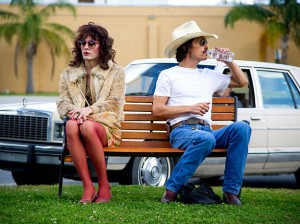Dallas Buyers Club
Posted on November 7, 2013 at 6:00 pm
 Matthew McConaughey lost nearly 40 pounds to play Ron Woodroof, a good-time party animal and homophobic Texas cowboy who was diagnosed with AIDS in 1986 and given a month to live. This was in the early days, before safe and effective drugs to treat HIV and AIDS were available. “We’re surprised you’re even alive,” says the doctor (Denis O’Hare). A kinder-hearted doctor (a beatific Jennifer Garner) suggests a support group to talk about his “feelings and concerns.” This is not what he is looking for. “I’m dying and you’re telling me to get a hug from a bunch of f***?” He is the kind of guy who might pray for help, but would talk to God in a strip bar.
Matthew McConaughey lost nearly 40 pounds to play Ron Woodroof, a good-time party animal and homophobic Texas cowboy who was diagnosed with AIDS in 1986 and given a month to live. This was in the early days, before safe and effective drugs to treat HIV and AIDS were available. “We’re surprised you’re even alive,” says the doctor (Denis O’Hare). A kinder-hearted doctor (a beatific Jennifer Garner) suggests a support group to talk about his “feelings and concerns.” This is not what he is looking for. “I’m dying and you’re telling me to get a hug from a bunch of f***?” He is the kind of guy who might pray for help, but would talk to God in a strip bar.
Woodroof, who had never shown any special interest in looking past the momentary thrills of rodeo riding, drinking, drugs, and sex, suddenly found he had courage, determination, and a fierce life force. He found that his ornery and rebellious personality perfectly suited him for taking on the medical establishment and the law. At the time, it was illegal to sell non-prescribed drugs but it was not illegal to give them away. And Texas happens to be across the border from Mexico, where the drugs he wanted were available. So he began to smuggle medication from Mexico and give it to members of the “buyers club” he set up. They paid a monthly “membership fee” and then the drugs were “free.”
McConaughey, pared down to nothing but grit and sinew, gives the most recent in a series of performances of sensitivity and scope that show how wrong Hollywood was to relegate him to forgettable romantic comedies. And the immensely gifted Jared Leto, always seemingly on the brink of a breakthrough since his days on “My So-Called Life,” is heartbreaking as Rayon, a trans woman who begins first a business relationship, then a friendship with Ron and finally becomes his family. There’s no winking at the audience, not a hint of “look how brave I am to be dressing in women’s clothes.” Leto, who lost a lot of weight and removed all of his body hair, did more than transform himself for the role. He stayed in character throughout the shoot. It is a reflection of his achievement in transforming himself into a character who was also transforming that one of the film’s most jarring images is when Rayon has to dress in a man’s business suit. It is understated but devastatingly clear that for Rayon, men’s attire is cross-dressing. We see how lost Rayon is, how far from herself, and how great a sacrifice she is willing to make to help the members of the Dallas Buyer’s Club. Rayon is no saint, but Leto gives her dignity and grace and he shows us why Woodroof and Jennifer Garner’s beatific doctor would be so devoted to her.
For Woodroof, the scene that shows how far he has come is when Rayon is insulted by one of the men from his rodeo days. As frail as he is, Woodroof can still put the guy in a headlock to insist on an apology, knowing that this means he can never go back to his old friends. But it is just a recognition of what he has already known. His diagnosis has moved him to another country, and one in which he found the shared retrovirus is a stronger bond than any he had ever made before.
The film wisely makes it clear that the symptoms of a fatal disease do not include a complete personality transformation; indeed, it is the qualities that got Woodroof into trouble that are the keys to his success in finding a way around the rules. More important, with nothing left to lose, Woodroof finds for the first time that he has something to give.
Parents should know that this movie includes constant very strong language, explicit sexual references and situations with nudity, drinking, smoking, and drug use, themes of fatal illness and sad deaths, and some fighting and tense confrontations.
Family discussion: How does the diagnosis make Woodroof feel differently about his life? What makes him change his mind about Rayon?
If you like this, try: the documentary, “How to Survive a Plague”
